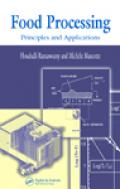
Cover 

Food Processing: Principles and Applications
Author:ISBN10: 1587160080
ISBN13: 9781587160080
Publisher: CRC Press
Price: $109.95
Pages: 440
Edition:
Publish date: agosto 2005
Outline:
× Covers terms, definitions, units and dimensions, mass and energy balance fundamentals, and practice problems × Highlights applications, problem solving, and modeling through the presentation of lab experiments, practice problems, and problem sets, each corresponding with the topics discussed × Provides an overview of food processing techniques such as blanching, pasteurization, sterilization, freezing, drying, post harvest storage, psychrometry, moisture sorption isotherms, water activity, osmotic drying, freeze concentration, ultrafiltration, and reverse osmosis Food Processing: Principles and Applications is a comprehensive resource that explores the basic and applied aspects of food processing. It describes the physical, chemical, and microbiological basis for each method of preservation. Particular emphasis is placed on the application of three of the most universally used commercial processes: thermal processing, freezing, and dehydration. Thermal processing - perhaps the most widely used technology in the world - is examined in thorough discussions of the microbial basis of the process and on microbial destruction kinetics. Also described is the characterization of the heating behavior of foods and the equipment used for thermal processing. Low temperature preservation is also demonstrated with a focus on freezing. The fundamentals of the freezing process, and the techniques and equipment used in commercial freezing operations are also explained. The thermophysical properties and the modeling of freeze times are meticulously addressed in sequence. Aspects of dehydration are detailed from drying fundamentals to drying equipment, modeling, and storage stability. In the final section, separation processes are highlighted: evaporation, membrane processing, freeze concentration, extraction, and osmotic dehydration. This book is ideal for undergraduate students in food science who are taking courses in food processing. It is also a must have resource for food process engineers and researchers to forecast results of food processing methods.
página de índice


 companias
companias libros
libros